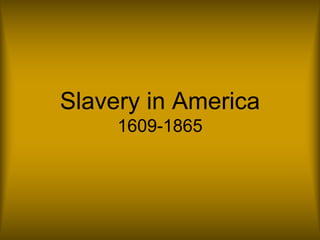
Slavery_In_America.pdf
- 2. Origins • Slavery has existed since the beginning of human history. • People were enslaved for a number of reasons some of which include; being captured in battle, owing a debt or being born to slave parents. • The word “slave” comes from the Slavic people of eastern Europe who were conquered so often that the their name became synonymous with servitude. • Most cultures around the world have practiced slavery in one form or another.
- 3. Middle Passage • The leg of the Atlantic slave trade that transported African people from Africa to slave markets in the Americas. • It was called the Middle Passage because it was the second of the three part triangle trade route. • Slaves were packed tightly on ships, shackled and fed very little for the 3-5 month journey. • About 18 million Africans were transported between 1600 and 1800, with about 3 million dying on the way.
- 4. Middle Passage 1 1 2 3 El Mino Slave Castle Ghana Doorway of no return
- 5. Arrival in America • Native Americans were originally enslaved by the Europeans, but after many died from diseases, they began importing African slaves who were resistant to European diseases. • The first African slaves arrived in America on a Portuguese ship at Jamestown, VA in 1609. • Prior to arrival in America slaves were usually fed better in order to make them look healthy. • Slaves were auctioned off to plantation owners and businessmen from the city and performed a variety of tasks. Slave Auction
- 6. Slave Codes • Slave codes were laws meant to control slaves. • These codes forbid slaves from learning to read, owning firearms, or marrying a white person. • The penalty a slave faced for learning to read was having a thumb cut off! • These laws also made the children born to slaves automatically slaves for life (generational slavery). The ends of a whip were tipped with iron barbs This slave collar was equipped with bells. A slave yolk was used to bind two slaves together. Captured African slave Slave tags, similar to dog tags were worn by slaves.
- 7. Slaves Resisted!! • Slaves didn’t just sit back and accept a life of servitude • Slaves resisted in a number of ways including; escaping, slowing down on the job, intentionally doing a job wrong or participating in violent rebellion. • One of the most famous slave revolts occurred in Virginia. A slave named Nat Turner led 70 other slaves in the killing of 55 white men, women and children. Turner and his men were later captured and hung. • Slaves also resisted by singing spirituals, or religious folk songs that often contained coded messages. • Slave spirituals led to the creation of both jazz and the blues. Southern account of Turner’s rebellion. Nat Turner Reward Poster
- 8. The Underground Railroad • The Underground Railroad was a large network of people who helped fugitive slaves escape to the North and to Canada. • It is estimated that up to 100,000 slaves escaped the South with the help of “conductors”, or guides. The most famous of these guides was Harriet Tubman. • Slaves escaping North would use a series of “stations”, or safe houses to rest in along the route. • The paths that slaves traveled towards the North were known as “tracks”. • While slavery was outlawed in the North, escaping slaves were not truly free until they reached Canada. This quilt shows the track pattern which told escaped slaves that this was a “station”, or safe place. Lawn Jockeys were used to mark stations on the underground railroad. Harriet Tubman
- 10. Bethel AME Church Greenwich Township Holden House Jersey City Peter Mott House Lawnside Croft Farm Cherry Hill Wheatley’s Burlington * In 1745 there were about 4,000 slaves in New Jersey, mostly in the southern part of the state.
- 11. The Abolition of Slavery • From 1861-1865 Americans in the North and South fought the Civil War over the issue of slavery. • A total of more than 600,000 people on both sides died. • In January of 1863, President Lincoln made clear that he sought to end the institution of slavery when he signed the Emancipation Proclamation. • After the war, the thirteenth amendment to the Constitution was added ending slavery in the U.S. • Slavery had been abolished in New Jersey since 1804. Emancipation Proclamation Lee surrendering to Grant